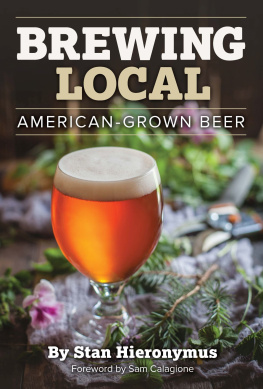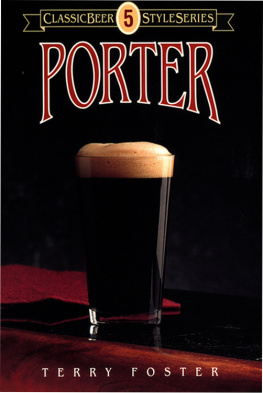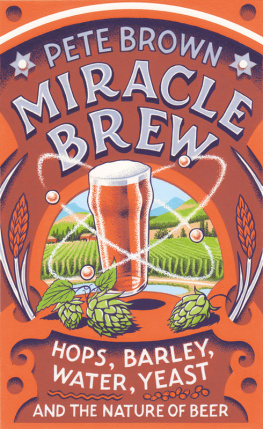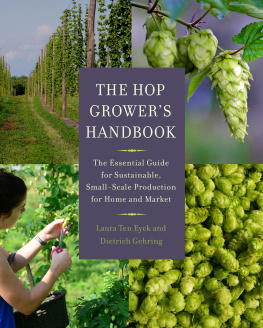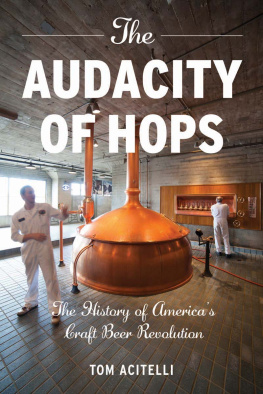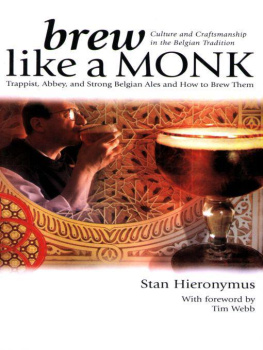For the Love of hops
The Practical Guide to Aroma, Bitterness and the Culture of Hops
Stan Hieronymus

Brewers Publications
A Division of the Brewers Association
PO Box 1679, Boulder, Colorado 80306-1679
BrewersAssociation.org
BrewersPublications.com
Copyright 2012 by Brewers Association
All rights reserved. No portion of this book may be reproduced in any form without written permission of the publisher. Neither the authors, editor nor the publisher assume any responsibility for the use or misuse of information contained in this book.
Printed in the United States of America.
10 9 8 7 6 5 4 3 2 1
ISBN: 1-938-469-01-1
ISBN-13: 978-1-938469-01-5
ISBN (epub edition): 978-1-938469-03-9
Library of Congress Cataloging-in-Publication Data
Hieronymus, Stan.
For the love of hops : the practical guide to aroma, bitterness, and the culture of hops / by Stan Hieronymus.
pages cm
Summary: Discusses the science and culture of hops, exploring such topics as history, hop varieties, brewing and dry-hopping techniques, and provides commercial recipes for brewing beer-- Provided by publisher.
ISBN-13: 978-1-938469-01-5
ISBN-10: 1-938469-01-1
1. Hops. 2. Brewing. 3. Beer. I. Title.
SB317.H64H54 2012
633.82--dc23
2012033604
Publisher: Kristi Switzer
Production & Design Management: Stephanie Johnson Martin
Cover and Interior Design: Julie White
Cover Illustration: Alicia Buelow
Technical Editor: Dr. Christina Schnberger
Copy Editing & Indexing: Daria Labinsky
To all of those who have been scratched by the hops.
Table of Contents
Acknowledgments
In the final paragraphs of this book, David Grinnell of Boston Beer Company observes, There are people who have given their life to this plant. For the Love of Hops would not have made it to print without their help nor without the generosity of many others.
I have no idea why Evan Rail ventured out from Prague to the Czech Republic countryside on a ridiculously cold February day to collect the recipe for 14 Tmav Speciln Pivo, but I am grateful, and you should be, too. I could offer scores of similar stories about other people I must thank but will try to be brief.
If Kristi Switzer, publisher at Brewers Publications, hadnt given me the chance, I never would have started the book. If Daria Labinsky, my wife, didnt encourage the pursuit of what some would call frivolous endeavors and offer the copy editing support every writer needs, I never would have finished it.
If Christina Schnberger, Val Peacock, Tom Shellhammer, Tom Nielsen, Peter Darby, Matt Brynildson, and Larry Sidor didnt know so much about hops, I might have given up before there was a Table of Contents. I owe particular thanks to Christina, for a) emailing me information I wasnt able to find elsewhere, b) keeping me up to date on the latest research, and c) providing her unique technical expertise during the editing process.
Of course, I must thank Ken Grossman for writing the foreword, but perhaps even more for creating an atmosphere at Sierra Nevada Brewing that is conducive to discovery and innovation. I spent no more important research time than that at Sierra Nevada. Each book has a moment or two when things come into focus. For this one, the first was when I sat in on a talk titled Dissecting Hop Aroma in Beer by Tom Nielsen from Sierra Nevada at the 2008 Craft Brewers Conference, long before I knew I would be writing this book. The second was during a conversation with Anton Lutz and Elisbeth Seigner at Hll Hop Research Center, when I realized how far into the twenty-first century Lutz was already thinking.
I also appreciate John Harris summarizing hop selection much better than I could have, and Peter Darby, Martyn Cornell, and Chris Swersey for providing an extra set of eyes and returning an unreasonable number of emails. Gayle Goschie, Jason Perrault, Florian Seitz, and Leslie Roy, in particular, took time to explain the curiosities of hop growing to a Midwesterner who was reared in the middle of corn and soybean fields. Then Ralph Olson, Jim Solberg, Paul Corbett, and almost everybody at Brewers Supply Group did the same with the hop trade. Also, I should thank a thousand brewers who have shown me their hops over the years, but will keep it to seven: Ron Barchet, Yvan de Baets, Vinnie Cilurzo, Dan Carey, Richard Norgrove, Ted Rice, and Eric Toft.
Just as important were people who helped me find information I wouldnt have found otherwise and got me to where I needed to be. Thanks first to Otmar Weingarten, managing director of the Hallertau and German Hop Growers Association, for his hospitality. Also to Ute Lachermeier, Jrgen Weishaupt, Michal Kovarik, Troy Rysewyk, Glenn Payne, John Humphreys, and Rebecca Jennings.
Finally, there was the matter of turning the manuscript, and all its parts, into a book. Thanks, once again, to Stephanie Johnson Martin and Julie White for making that happen.
A few days before the 2011 harvest began I sat on the Tettnang town square with Weishaupt, managing director of Tettnanger Hopfen, and listened to a community band play. He later introduced me to one of the clarinet players, a former Tettnang hop queen. Earlier that day he had said, We like to say we live with the hops.
Now I can say the same. I have to thank my familyDaria, Ryan, and Sierrafor letting me do that.
Foreword
Although I dont have an exact recollection, I have to believe that my first encounter with the aroma of hops probably occurred sometime in my fifth or sixth year of life. While growing up, I spent a lot of time at my neighbors/good friends house. His father, Cal, besides being a metallurgical rocket scientist at Rockwell, was an accomplished homebrewer. Throughout my childhood I watched him spend many weekends in the kitchen with large pots on the stove, boiling together what appeared to be mysterious potions from an assortment of exotic ingredients. I was intrigued with his makeshift brewing equipment, which was composed of colanders, hoses, and buckets that he had co-opted and converted from his wifes kitchen and the hardware store, long before such things had been developed for hobbyists. I still vividly recall the occasional and exciting boilover and the unbridled reaction of his generally tolerant wife to the mess on her stove. The unusual aroma of boiling wort captivated me early on. Although some people find it disagreeable, I was mesmerized by the pungent, sweet malt and floral hop aroma. It wasnt like anything I had ever smelled before.
For years growing up, I was regularly around the entire brewing process, from simmering kettle, covered crocks, and plastic buckets with foamy heads, to a row of glass carboys with their airlocks bubbling away on the service porch. When we were older, we would occasionally get tasked to help wash bottles or put caps on during bottling day. Brewing was Cals hobby, and it soon became my passion. I now understand that this early exposure to hops and brewing had a major influence on my career path, and, later on, the style of beers I chose to brew and enjoy. I have often asked myself the question, Would I be a brewer today if I hadnt been seduced at an early age by the fragrant hop? I have been what is now called a hop head for most of my life. Although I enjoy and appreciate a range of beer styles, I always gravitate to the hoppy side and never tire of the complex and aromatic qualities that the wonderful hop has to share.
My neighbor started brewing before quality ingredients, particularly hops, were available for hobbyists. Luckily, he had befriended someone who worked in a large, international brewery and occasionally received samples of some of the finest hops from around the globe. They were leaps and bounds better than what was generally available in homebrew supply shops, and had origins in faraway places like England, Yugoslavia, Poland, Germany, and Czechoslovakia. Later, as I became an aspiring homebrewer, I remember how fortunate I was to have access to these generally unknown and unavailable hops and how much they improved the quality of my beer.


